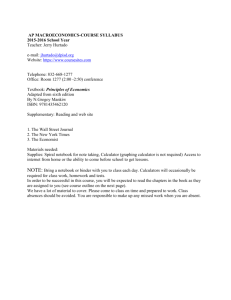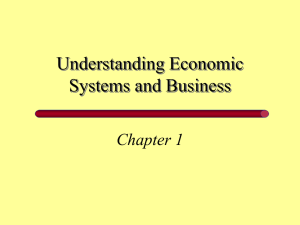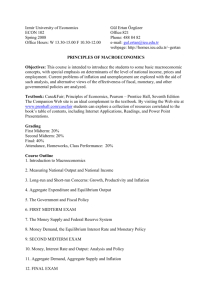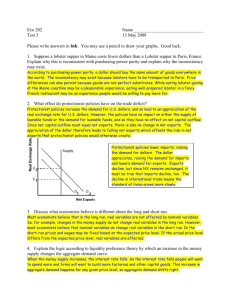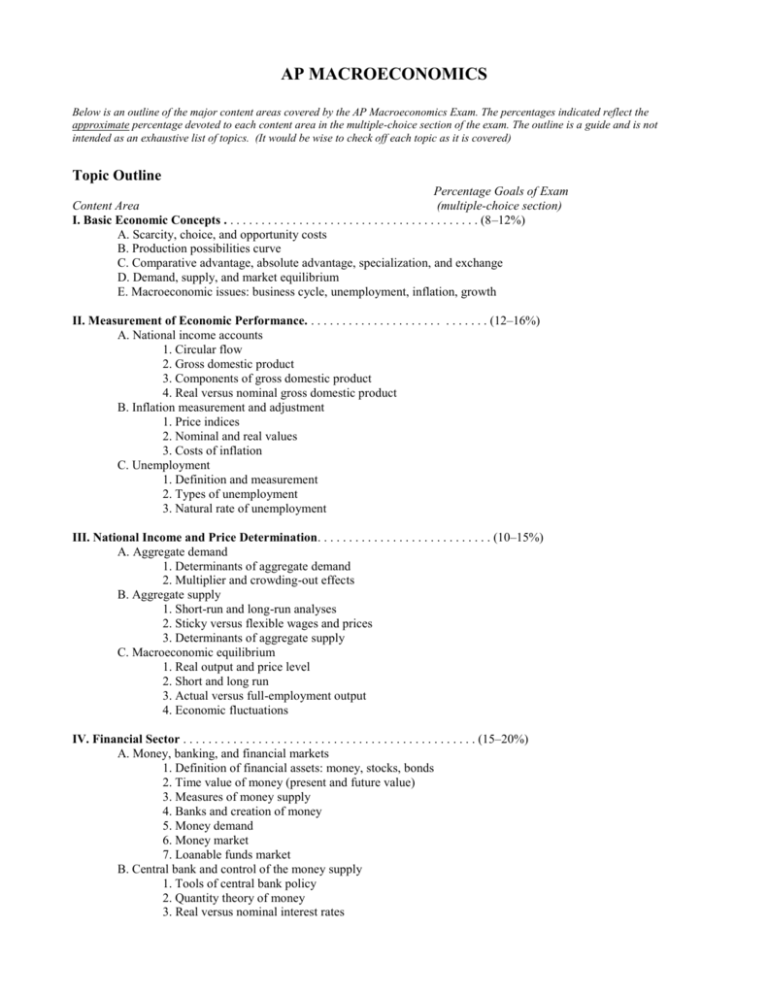
AP MACROECONOMICS
Below is an outline of the major content areas covered by the AP Macroeconomics Exam. The percentages indicated reflect the
approximate percentage devoted to each content area in the multiple-choice section of the exam. The outline is a guide and is not
intended as an exhaustive list of topics. (It would be wise to check off each topic as it is covered)
Topic Outline
Percentage Goals of Exam
Content Area
(multiple-choice section)
I. Basic Economic Concepts . . . . . . . . . . . . . . . . . . . . . . . . . . . . . . . . . . . . . . . . . (8–12%)
A. Scarcity, choice, and opportunity costs
B. Production possibilities curve
C. Comparative advantage, absolute advantage, specialization, and exchange
D. Demand, supply, and market equilibrium
E. Macroeconomic issues: business cycle, unemployment, inflation, growth
II. Measurement of Economic Performance. . . . . . . . . . . . . . . . . . . . . . . . . . . . . (12–16%)
A. National income accounts
1. Circular flow
2. Gross domestic product
3. Components of gross domestic product
4. Real versus nominal gross domestic product
B. Inflation measurement and adjustment
1. Price indices
2. Nominal and real values
3. Costs of inflation
C. Unemployment
1. Definition and measurement
2. Types of unemployment
3. Natural rate of unemployment
III. National Income and Price Determination. . . . . . . . . . . . . . . . . . . . . . . . . . . . (10–15%)
A. Aggregate demand
1. Determinants of aggregate demand
2. Multiplier and crowding-out effects
B. Aggregate supply
1. Short-run and long-run analyses
2. Sticky versus flexible wages and prices
3. Determinants of aggregate supply
C. Macroeconomic equilibrium
1. Real output and price level
2. Short and long run
3. Actual versus full-employment output
4. Economic fluctuations
IV. Financial Sector . . . . . . . . . . . . . . . . . . . . . . . . . . . . . . . . . . . . . . . . . . . . . . . (15–20%)
A. Money, banking, and financial markets
1. Definition of financial assets: money, stocks, bonds
2. Time value of money (present and future value)
3. Measures of money supply
4. Banks and creation of money
5. Money demand
6. Money market
7. Loanable funds market
B. Central bank and control of the money supply
1. Tools of central bank policy
2. Quantity theory of money
3. Real versus nominal interest rates
Percentage Goals of Exam
Content Area
(multiple-choice section)
V. Inflation, Unemployment, and Stabilization Policies . . . . . . . . . . . . . . . . . . . . . . . . .(20–30%)
A. Fiscal and monetary policies
1. Demand-side effects
2. Supply-side effects
3. Policy mix
4. Government deficits and debt
B. Inflation and unemployment
1. Types of inflation
a. Demand-pull inflation
b. Cost-push inflation
2. The Phillips curve: short run versus long run
3. Role of expectations
VI. Economic Growth and Productivity . . . . . . . . . . . . . . . . . . . . . . . . . . . . . . . (5–10%)
A. Investment in human capital
B. Investment in physical capital
C. Research and development, and technological progress
D. Growth policy
VII. Open Economy: International Trade and Finance . . . . . . . . . . . . . . . . . . . . . . . . . . .(10–15%)
A. Balance of payments accounts
1. Balance of trade
2. Current account
3. Capital account
B. Foreign exchange market
1. Demand for and supply of foreign exchange
2. Exchange rate determination
3. Currency appreciation and depreciation
C. Net exports and capital flows
D. Links to financial and goods markets
Macroeconomics
© 2006 The College Board. All rights reserved. Visit apcentral.collegeboard.com (for AP professionals) and
www.collegeboard.com/apstudents (for students and parents).





